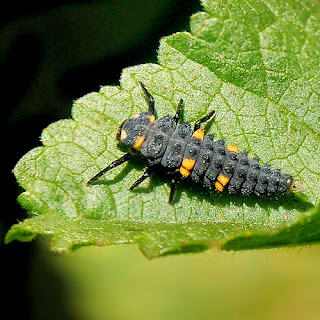Ladybird Larvae
I have noticed a lot of ladybird larvae on my plot recently. They are very small, and don't look like ladybirds at all. Like the adults, the larvae are the gardeners friend, so be careful not to harm them.
Throughout March and April, the adult ladybirds have been feeding on aphids (greenfly). In May they mate, and the female ladybird lays her eggs which hatch into the larvae. Luckily for us, the larvae also feed exclusively and voraciously on aphids, before entering the pupae stage, from which they emerge, in August, as new adult ladybirds.
Ladybirds spend the winter months in a dormant state. By providing them with a warm, sheltered place to overwinter you can help them survive to produce another generation of aphid-munching ladybirds on your allotment. A single ladybird can devour 5,000 aphids in its lifetime.
There are expensive 'bug hotels' you can buy, but it is easy, and satisfying, to make your own - not just for ladybirds, but also the many species of bees and hoverflies which are so beneficial to growing.
Throughout March and April, the adult ladybirds have been feeding on aphids (greenfly). In May they mate, and the female ladybird lays her eggs which hatch into the larvae. Luckily for us, the larvae also feed exclusively and voraciously on aphids, before entering the pupae stage, from which they emerge, in August, as new adult ladybirds.
Ladybirds spend the winter months in a dormant state. By providing them with a warm, sheltered place to overwinter you can help them survive to produce another generation of aphid-munching ladybirds on your allotment. A single ladybird can devour 5,000 aphids in its lifetime.
There are expensive 'bug hotels' you can buy, but it is easy, and satisfying, to make your own - not just for ladybirds, but also the many species of bees and hoverflies which are so beneficial to growing.
Submitted by Jane, plot 9

Comments
Post a Comment